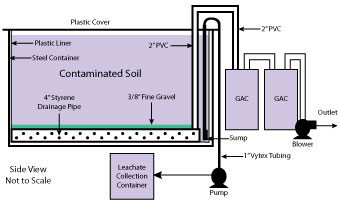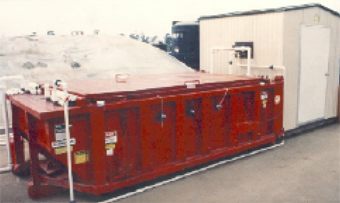Bioremediation
Aerobic Bioremediation (Direct)
- Overview
- Aerobic Bioremediation (Direct)
- Anaerobic Bioremediation (Direct)
- Cometabolic Aerobic and Anaerobic Bioremediation
- Training
Additional Information
![]() A Summary of the DOE/PERF Bioremediation Workshop May 30, 2002 Houston, Texas
A Summary of the DOE/PERF Bioremediation Workshop May 30, 2002 Houston, Texas
DOE, 25 pp, 2002
This document is a summary of a joint bioremediation workshop held in Houston, Texas on May 30, 2002, by the United States Department of Energy and the Petroleum Environmental Research Forum. The main objective of the workshop was to discuss the "state of the art" of bioremediation for hydrocarbon-impacted soil. Key findings from bioremediation research on marine, freshwater, and wetland oil spills were presented. Presentations at the workshop addressed bioremediation as practiced by the oil industry, toxicity assessment after bioremediation, and other technical issues. This workshop summary has been written in a "Question and Answer" format in order to provide the information in a concise manner for environmental professionals who are considering the use of bioremediation at sites where hydrocarbons have impacted soils.
![]() Advances in the State of the Practice for Enhanced In Situ Bioremediation
Advances in the State of the Practice for Enhanced In Situ Bioremediation
Kucharzyk, K. and S. Rosansky.
Naval Facilities Engineering Command, TR-NAVFAC EXWC-EV-1806, 26 pp, 2018
Enhanced in situ bioremediation (EISB) is an engineered technology that introduces physical, chemical, and biological changes to the aquifer to create the conditions necessary for microorganisms to transform contaminants of concern to innocuous byproducts. Recent innovations and trends to facilitate successful application are introduced. While this document primarily discusses current industry-accepted best practices to design and apply EISB for chlorinated ethene remediation, it also discusses progress in identifying microorganisms capable of degrading 1,4-dioxane.
![]() Aerobic Biodegradation of Oily Wastes: A Field Guidance Book for Federal On-Scene Coordinators
Aerobic Biodegradation of Oily Wastes: A Field Guidance Book for Federal On-Scene Coordinators
Version 1.0, October 2003
EPA Region 6
The objective of this field guide is to provide guidance (primarily to federal On-Scene Coordinators) in selecting and conducting land aerobic biodegradation of oil-contaminated wastes from inland oil spills, leaking/unplugged oil wells, abandoned oil refinery sites, pipeline ruptures, and tank failures. The first part of the field guide provides information to help evaluate the nature of the environment where land treatment is considered and a summary of the existing regulations and policies (in EPA Region 6). The second part provides an overview of the factors to be considered and studied when determining if land farming is a viable option and also discusses key points in the process design. The last part focuses on operation issues and provides useful tools and information for efficient management of aerobic land treatments.
![]() Biocell Technology: Remediation of Petroleum-Contaminated Soils
Biocell Technology: Remediation of Petroleum-Contaminated Soils
1998
This technology data sheet describes biocell (bioreactor) technology and provides information on the research on and demonstration of this technology at the Army's Waterways Experiment Station, where petroleum-contaminated soils were loaded into a 10 yd3 biocell. Aerobic microbial activity was stimulated within the soils through aeration.
![]() Bioremediation of Chlorinated Volatile Organic Compounds: DOE Experiences and Lessons Learned
Bioremediation of Chlorinated Volatile Organic Compounds: DOE Experiences and Lessons Learned
Looney, B.B., D.T. Newby, H.H. VerMeulen, and E.D. Fabricatore. Savannah River National Laboratory Report SRNL-STI-2025-00051, 96 pp, 2025
This systematic review examined the design, objectives, performance, and outcomes for remediation projects at DOE sites, including Savannah River, Hanford, Idaho, Mound, and Pinellas. Results were used to identify emergent themes and provide actionable insights. Standardized criteria were first developed to support the systematic review. Then, the evaluation was performed using a sequential process that was informed by local technical experts, who identified and provided the structured information that served as the basis for the evaluation. To maximize the value of the DOE cVOC bioremediation retrospective, the review strategy focused on identifying important DOE-specific experiences, trends, and lessons learned that would extend the knowledge available from these other key entities. Overarching themes that were identified are included in the report. More specific technical findings are provided in the lessons learned section of the report. The portfolio of cVOC bioremediation projects and DOE project experience has yielded significant success. Two sites have formally transitioned to a passive enhanced attenuation (EA) remedy from pump and treat, discontinuing expensive active treatment and now moving rapidly toward closure with no further action. All wells and all constituents at both EA sites are near or below MCLs. Some of the full-scale anaerobic bioremediations are also approaching ROD reviews, where they may be able to formally transition to a passive EA remedy. Within these projects, DOE has developed, tested, and deployed several innovative technologies, some of which are patented and licensed. DOE led the collaboration to develop technical guidance for implementing EA for cVOCs. The 30+ year period of DOE cVOC bioremediation experience summarized in this review can support DOE managers/decision makers as well as contractors in their project management, project design and field operations responsibilities for current and future cVOC bioremediation.
Cornell University Waste Management Institute (Composting)
This Resource Page contains a multitude of resources on small- and large-scale composting.
![]() Development of Bioreactors for Application of Biocatalysts in Biotransformations and
Bioremediation
Development of Bioreactors for Application of Biocatalysts in Biotransformations and
Bioremediation
2001
This paper summarizes research on application of biofilms of fungal and bacterial cells and their enzymes, including hydrolases, polyphenol oxidase, peroxidase and laccase, in bioreactor systems including continuously operating membrane bioreactors.
![]() Elucidation of the Mechanisms and Environmental Relevance of cis-Dichloroethene and Vinyl Chloride Biodegradation
Elucidation of the Mechanisms and Environmental Relevance of cis-Dichloroethene and Vinyl Chloride Biodegradation
Cox, E.
SERDP Project ER-1557, 170 pp, 2012
Major results of this project can be summarized as follows: (1) JS666 remains the only isolated organism known to mediate aerobic oxidation of cDCE to CO2, and DNA-based molecular biological tools exist to track its presence and fate during bioaugmentation projects; (2) significant advances were made in understanding the pathway, mechanisms, and enzymes associated with aerobic oxidation of cDCE in JS666; (3) anaerobic oxidation of cDCE and/or VC under iron- or manganese-reducing conditions could not be confirmed, despite substantial efforts with materials from many sites; (4) suspected anaerobic oxidation of VC may in fact be aerobic oxidation to CO2 at extremely low levels of oxygen in the subsurface; and (5) compound-specific isotope fractionation of carbon occurs in both anaerobic and aerobic microbial degradation of ethane, allowing the use of CSIA to assess ethene degradation as a possible means to explain poor ethene mass balance in enhanced in situ bioremediation and MNA projects.
This paper provides an overview of the potential use of composting technology in programs aimed at organic waste recycling (product-oriented perspective) or decomposition of hazardous materials.
Feasibility of Calcium Peroxide as an Oxygen Releasing Compound in Treatment Walls
2008
This paper investigates the use of a proprietary formulation of powdered calcium peroxide as an oxygen releasing compound in a treatment wall. Laboratory-scale column studies evaluated the release of oxygen and the permeability effects resulting from a treatment wall mixture of the calcium peroxide and representative aquifer sand. The research focused on measuring permeability effects within the treatment wall due to the initial addition and subsequent chemical reduction of the calcium peroxide and the degree to which dissolved oxygen concentration increased in water flowing out of the treatment wall.
Petroleum Bioventing
van Eyk, J. and A.A. Balkema, Rotterdam ; Brookfield, VT. ISBN: 9054106867. 302 pp, 1997
This book investigates the composition and the behavior of petroleum in soil, soil properties and soil processes, their interaction with bacterial processes, possibilities for optimizing the removal of petroleum hydrocarbons from soil by bacteria and it explains the phenomenon of recalcitrance.
![]() Procedures for Conducting Bioventing Pilot Tests and Long-Term Monitoring of Bioventing Systems
Procedures for Conducting Bioventing Pilot Tests and Long-Term Monitoring of Bioventing Systems
Downey, D., R. Miller, & T. Dragoo, Parsons Denver, CO. NTIS: ADA423587, 80 pp 2004
This report replaces AFCEE's 1992 'Test Plan and Technical Protocol for a Field Treatability Test for Bioventing' and identifies an updated approach for conducting bioventing pilot tests and monitoring the long-term progress of bioventing systems.
![]() Standardized Procedures for Use of Nucleic Acid-Based Tools: Recommendations for Groundwater Sampling and Analysis Using qPCR
Standardized Procedures for Use of Nucleic Acid-Based Tools: Recommendations for Groundwater Sampling and Analysis Using qPCR
Lebron, C., P. Dennis, C. Acheson, N. Barros, D. Major, E. Petrovskis, F. Loeffler, K. Ritalahti,
C. Yeager, E. Edwards, J. Hatt, and D. Ogles. SERDP Project ER-1561, 12 pp, 2014
SERDP project ER-1561 focused on identifying and minimizing the causes of variability during quantitative real-time polymerase chain reaction (qPCR) enumeration of genes of interest in groundwater, with the goal of developing of the knowledge needed to standardize methods for collecting, preserving, transporting, storing, and processing environmental samples for qPCR analysis. This document summarizes the project conclusions and recommends procedures for using qPCR analyses that will provide data of sufficient accuracy and reproducibility to allow site management decisions regarding bioremediation or MNA. Further details are available in the ER-1561 Final Report![]() (Lebron et al. 2014, 220 pages).
(Lebron et al. 2014, 220 pages).
![]() Using Chemical Priming as a Means of Enhancing the Performance of Biocells for Treating Petroleum Products Containing Recalcitrant Chemical Species
Using Chemical Priming as a Means of Enhancing the Performance of Biocells for Treating Petroleum Products Containing Recalcitrant Chemical Species
Wang, Winnie, et al., Mississippi State University, 158 pp, 2001
Biocell technology is a soil remediation technology that utilizes commercial roll-off dumpsters as simple, yet effective bioreactors. This report evaluates the effectiveness of using chemical oxidizers to aid in the bioremediation of petroleum hydrocarbons.






